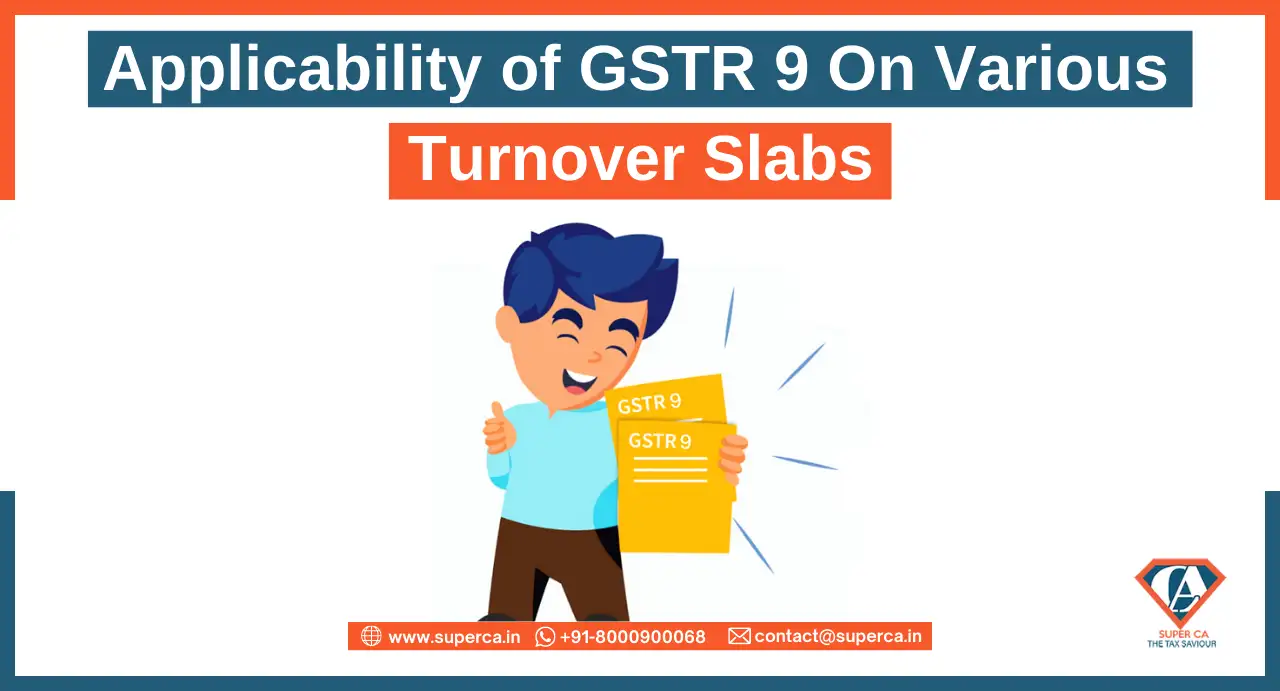Applicability of GSTR 9 On Various Turnover Slabs
- Posted By SuperCA
- On 27 October

About
GSTR-9 is an annual return which is to be filed annually by GST registered taxpayers. It is a compilation return which includes all business transactions done for the particular financial year and all the monthly/quarterly returns (GSTR-1, GSTR-2A, GSTR-3B) filed in that year. The main sources of populating GSTR-9 are the GST return filing of, GSTR-1 and GSTR-3B. The form contains a total of 6 parts spread out within 19 tables. Each part asks for details that are easily available from your previously filed return and books of account.
(Note : The government had made the filing of GSTR-9 /9A optional for the financial year 2017-18 and 2018-19 as small taxpayers were facing difficulties from the implementation of GST.
Further, in the 43rd GST Council Meeting, dated May 28, 2021 the council decided to amend Section 35 and Section 44 of the CGST Act as per Finance Act, 2021 and the changes will be applicable for the Financial Year 2020-2021. It was also decided at that in view of pandemic, GST return filing of form 9/9A for FY 2020-2021 will be optional for taxpayers having aggregate Annual Turnover up to Rs.2 Cr. and reconciliation statement in Form GSTR 9C will be made optional for taxpayers having aggregate Annual Turnover up to Rs.5 Cr.)
People required to file GSTR 9
CBIC has exempted GST-registered taxpayers with annual aggregate turnover up to Rs.2 crore in Financial Year 20-21 from annual GST return filing Form 9. But, GSTR-9 is compulsorily applicable to taxpayers with an annual total turnover of more than Rs.2 crore.
However, the option to file GST Annual Return shall be available and the taxpayers whose turnover is up to 2 crore rupees still can file the Annual Return in Form GSTR-9 on voluntary basis.
All registered regular taxpayers under GST are liable to file GSTR 9 except :
- Casual Taxable Person
- Non- Resident Taxable Person
- Input Service distributor
- Person paying TDS u/s 51 or TCS u/s 52
Applicability on various turnover limits
|
Turnover limit |
GSTR-9 Applicability |
GSTR-9C Applicability |
|
Up to Rs 2 Crores |
Optional |
Not applicable |
|
More than Rs. 2 Crores and up to Rs. 5 Crores. |
Applicable |
Not applicable |
|
More than Rs. 5 Crores |
Applicable |
Applicable |
Due Date and Penalty.
Every registered person is required to file the annual return on or before 31st December of the subsequent financial year.
Late fees for late filing of Annual return is Rs 200/day (Rs 100 each under CGST and SGST Act). This is subject to a maximum of 0.25% of the taxpayer’s turnover.
Different Types of GSTR 9
● GSTR 9 - It is an annual return which is required to be filed by every registered person irrespective of the threshold limit of turnover. It should be noted that GSTR-9 filing for businesses with turnover up to Rs 2 crore made optional for FY 17-18, FY 18-19 and FY19-20.
● GSTR 9A - It is an annual return for the supplier who was under composition scheme as per section 10 of CGST Act anytime during the relevant financial year.
● GSTR 9B - It is an annual return To be filed by e-commerce operators who have filed GST return filing form 8 during the financial year.
● GSTR 9C - It is a reconciliation statement between the annual gst return filing done in GSTR 9 and the taxpayer’s audited annual financial statement. It is to be certified by CA / CMA for registered persons with turnover of more than two crore.
Cessation
Since the GST return filing form 9 contains annual details of GST liability, ITC claimed, turnover made after considering various returns filed, including GSTR-2A, therefore it acts as a crucial documentary proof and helps the taxpayer to avoid future potential litigation that could follow. Timely GST return filing is one of the important parameters considered for better compliance rating. Thus, it helps the taxpayer to improve their compliance rating.
GSTR 9 annual return also helps to summarise the data of the entire financial year. If the taxpayer ignores filing GSTR-9, it doesn't mean that he/she will be spared from potential GST notices for discrepancies in GSTR-1 and 3B. Therefore in order to avoid unnecessary and unpleasant consequences you must file GSTR-9.
Further, just like annual ITR, GSTR-9 can also act as an useful document to prove the health of your business and your compliance status in front of the financial Institutions.





